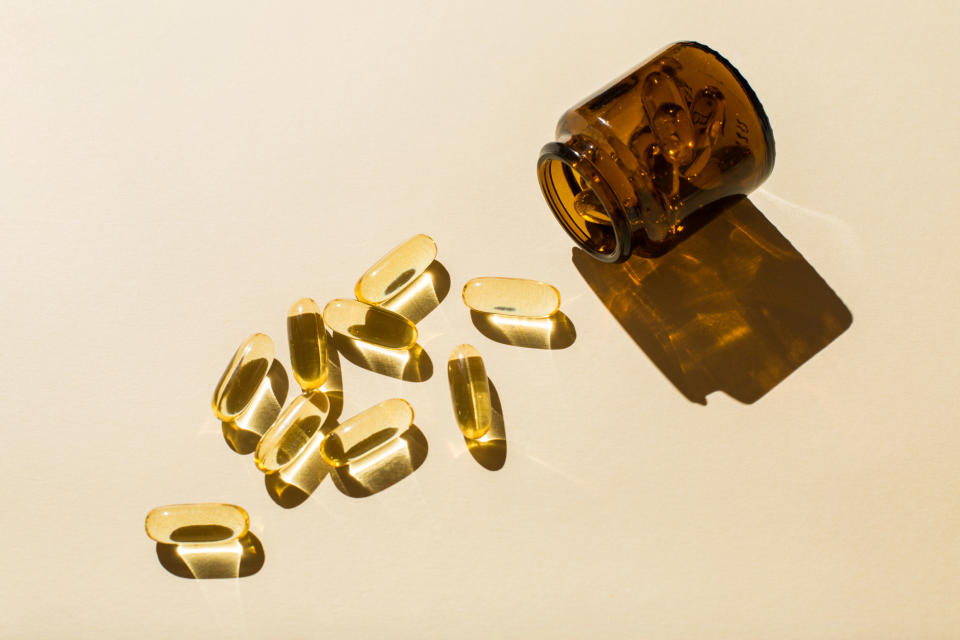How Vitamin D for Thyroid Helped One Woman Beat Fatigue: "I Feel Like I've Aged Backward!"
A sluggish thyroid can wreak havoc on your body, from intense fatigue to brain fog to muscle and joint pain. And while there are dozens of medications out there that can help, more and more recent studies have been shown a strong link between vitamin D and thyroid health. It's an easy, inexpensive remedy that made all the difference for Christine Marie Smith, who'd been suffering from fatigue for years. Read on for her story and learn how to use vitamin D for thyroid.
Why vitamin D is good for your thyroid
Deficits in vitamin D increase the odds of thyroid slowdowns by 70%, say researchers in the journal BMC Endocrine Disorders. “Vitamin D is the switch that turns on thyroid hormone so it can optimize metabolism and increase the activity of mitochondria, the energy-generating ‘power plants’ inside cells,” explains Richard Shames, MD, creator of ThyroidPower.com.

How to correct a vitamin D deficit
Studies show that more than 90% of women with a slow thyroid are low in vitamin D. As a result, they often experience fatigue, brain fog, blue moods and more.
Your doctor can order blood tests to identify vitamin D deficits, and home tests are available at Everlywell. Dr. Shames recommends women with an underactive thyroid aim for a vitamin D level of 60 to 70 ng/dL. If testing reveals a shortfall, the two steps below can help.
1. Supplement with vitamin D-3
Dr. Shames recommends taking up to 6,000 IU a day until you hit optimal levels, then retesting after three months to make sure you maintain them. (Note: Too much vitamin D can be toxic over time, so drop your dose by 1,000 IU daily if levels reach 80 ng/dL or more).
2. Spend time in the sun
The body makes vitamin D when sunlight strikes skin, so Dr. Shames advises aiming for 20 minutes of midday sun exposure daily before applying sunscreen.
How to make vitamin D work harder
Taking vitamin D with the biggest meal of the day increases levels of the vitamin by 50% in as little as two months, say researchers at the Cleveland Clinic. Why? The largest meal typically contains fat, and as Dr. Shames notes, “Vitamin D is fat-soluble, so fat enhances its absorption.” Indeed, a study in the Journal of the Academy of Nutrition and Dietetics found that the presence of fat in a meal significantly increased vitamin D absorption. Also smart: Make sure your meal contains magnesium-rich foods like nuts, seeds or leafy greens since magnesium activates enzymes that help the body metabolize vitamin D.
Vitamin D for thyroid success story: Christine Marie Smith

Christine Marie Smith
For years, Christine Marie Smith, 46, fought fatigue. Then a doctor urged her to try the easy, inexpensive remedy that made all the difference.
“Honestly, I don’t even know how you’re functioning,” Smith, then 38, recalls her doctor saying in 2016 after reviewing her blood work. “That’s when it really hit me: The way I was living was not normal. I’d been doing Pilates and I thought I was eating right and getting enough sleep, but I was exhausted most of the day,” she says.
“My job as an interior designer and real estate investor is very busy. I deal with contractors, architects and inspectors, and I can’t get my work done if I’m exhausted. For years, I was so wiped out that it was hard for me to do everyday tasks as simple as meal prep. One day, my daughter asked me to do something, and before I could reply, she said, ‘It’s okay, Mom, I know you’re tired.’ I felt like the worst mom in the world.
Searching for answers
“I was desperate to figure out what was going on. That’s how I ended up at my doctor that afternoon. He told me that my vitamin D was very low, my thyroid was underactive and I had a lot of inflammation in my body. Years before, I had been diagnosed with hypothyroidism, which can make you drowsy, and I had been taking the thyroid medication Synthroid. But the medicine wasn’t working. At this point, the doctor also diagnosed me with Hashimoto’s disease, another condition that affects the thyroid, and switched me to the natural hypothyroid medication Armour Thyroid.
“I started supplementing with vitamin D-3 to boost my levels, but I was still tired. I was also dealing with brain fog, muscle weakness and joint pain — symptoms of low vitamin D. I was so frustrated and wondered if I’d ever get better.
“One day, I was talking to a friend about my struggles. He owns AgeRejuvenation Medical Spa in Tampa, Florida, and suggested I visit their medical director, Dawn Ericsson, MD, to see if she could help me. At that point, I had tried so many things, and nothing had helped, but I made an appointment, thinking, What’s the worst that could happen?
“Dr. Ericsson did more tests and discovered that my body struggled to convert the inactive form of thyroid hormone T-4 into T-3, the active form. Over what turned out to be several years, she adjusted my medication until we eventually discovered that taking a daily dose of 180 mg of Armour Thyroid worked for me.
“But I was still exhausted. Dr. Ericsson ordered blood tests, which revealed that I was very deficient in vitamin D. She explained that vitamin D is integral in supporting thyroid function and suggested I start supplementing. I did, and my energy improved.
“Then COVID hit. I was overwhelmed with work, and like so many others, I was out of my routine. I started forgetting to take my vitamin D supplements and felt the fatigue return.
Energy restored!
“In 2021, I went back to Dr. Ericsson, who found that my vitamin D levels were still low. This time, she told me to take a combination of vitamins D-3 and K-2, explaining that when you take the vitamins together, they direct calcium to the bones to keep them healthy. Since then, I’ve been diligent about taking Solaray Vitamin D3 + K2, which contains 5,000 IU of D-3 and 50 mcg of K-2.
“Over time, I noticed I felt better than I ever had taking D-3 alone. And my energy continued to improve when Dr. Ericsson added in a supplement called Now Thyroid Support, which has ingredients including zinc, selenium, copper, folate, B-12, B-6 and iodine, all of which are good for the thyroid.
“Today, I feel amazing. My most recent blood work was the best I’ve had. I feel like I’ve aged backward. When I wake up in the morning, my mind is clear and I’m ready to get going. This simple change made all the difference in the world. Dr. Ericsson literally changed my life!”
For more inspiring real-life health stories, click through:
“My Chronic Headaches Are Gone!” — How One Woman Got Relief With Magnesium for Migraines
Lyme Disease Is on the Rise: How One Woman Cured Herself With Biomagnetic Therapy
“I Finally Got My Life Back!” — How One Women Found Relief for Long COVID Fatigue

